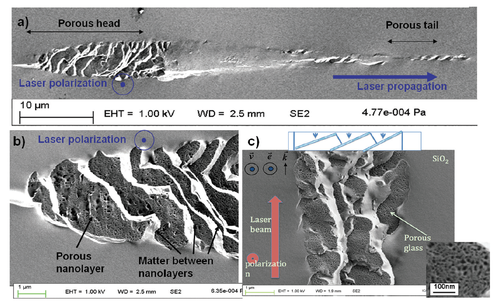Ultrafast nanoporous silica formation driven by femtosecond laser irradiation
A type of glass modifications occurring after femtosecond laser irradiation gives rise to strong (10−2). This form birefringence is thought to be related to index nanostructure (called nanogratings). Analyzing induced tracks in fused silica using scanning electron microscopy (SEM) with nm resolution shows that nanostructures are porous nanoplanes with an average index lower than typical silica (n ∼ –0.20). Their origin is explained as arising from fast decomposition of the glass under localized, high-intensity femtosecond laser radiation where strong nonlinear, multiphoton-induced photoionization leads to plasma generation. Mechanistic details include Coulombic explosions characteristic of strong photoionization and the production of self-trapped exciton (STE). Rapid relaxation of these STE prevents recombination and dissociated atomic oxygen instead recombines with each other to form molecular oxygen pointed out using Raman microscopy. Some of it is dissolved in the condensed glass whilst the rest is trapped within nanovoids. A chemical recombination can only occur at 1200°C for many hours. This explains the thermal stability of such a nanostructure. Precise laser translation and control of these birefringent nanoporous structures allows arbitrarily tuning and positioning within the glass, an important tool for controlling optical properties for photonic applications, catalysts, molecular sieves, composites...

FEG-SEM secondary electrons images of laser tracks cross section for each writing laser polarization. The laser parameters were: 0.5 μJ/pulse, 1030 nm, 300 fs, 200 kHz, 200 μm/s i.e. 103 pulses/μm. A focusing lens of 0.5 NA was used. With the laser polarization parallel (a) to the scanning direction. (b) and (c) show close-ups of the porous regions.

